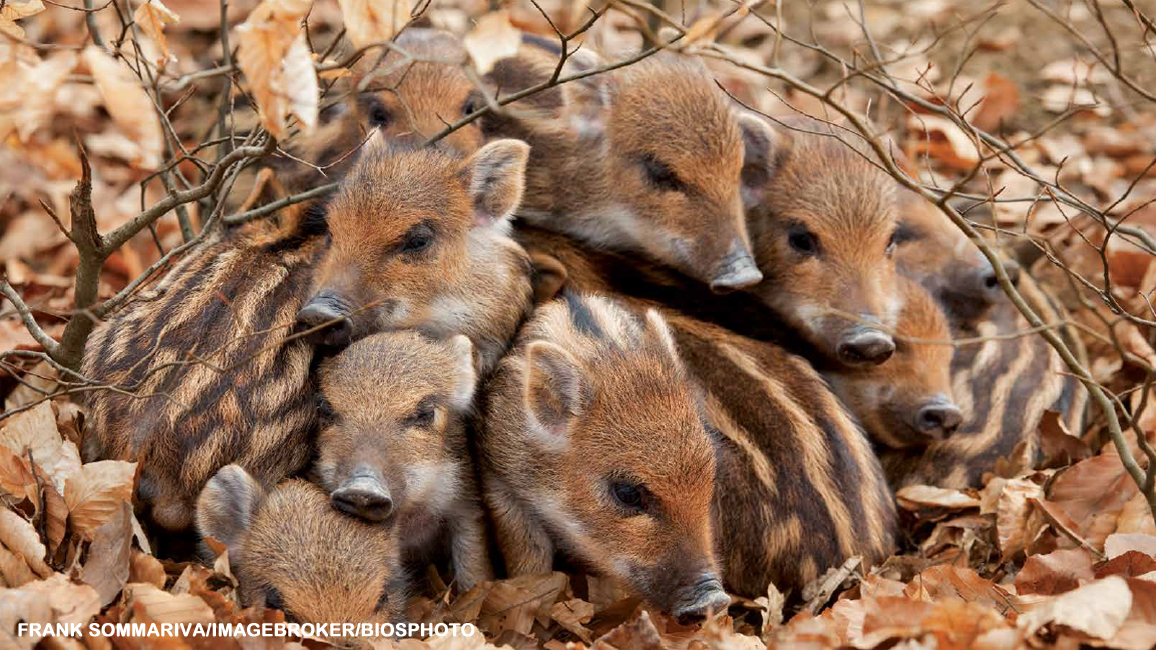
Meet the Boars
By Kathy KrankingWhat’s this mound of mystery animals?

If you thought the animals (above) looked like piled-up piglets, you were right! They’re baby wild pigs called Eurasian (yur-AY-zhun) boars.

So what exactly are boars? Boars are the wild cousins of domestic pigs. Eurasian boars live throughout most of Europe and Asia (see map below) in all kinds of places, from woods and fields to suburbs and even cities. (The map shows their native, or natural, home. They also live in other areas, where they are considered invasive. More on that later.)
Unlike most of their domestic pig cousins, Eurasian boars have thick fur that has two layers: a soft undercoat and an outer coat of longer, bristly hairs. The coats of adult boars can vary in color from black to brownish-red. Eurasian boars have a set of long teeth called tusks. Males and females have both upper and lower tusks. But the upper tusks of males never stop growing. They are curved and much longer than those of females, and they show outside their mouths.
A COOL TOOL
One of the first things you might notice about the Eurasian boar is its long, strong snout. The snout has muscles connected to a flat disc, where the boar’s nostrils are. The disc is made of cartilage (CAR-tuh-lij), the same flexible stuff that your ears are made of.
A boar uses its powerful snout as a built-in bulldozer, pushing up dirt while it looks for roots and other food. It can dig holes up to four feet deep and can even use its snout to move heavy logs out of the way as it searches for something to eat! And when it comes to eating, Eurasian boars aren’t picky at all.
Besides eating roots, they go for bulbs that they dig up as well as other plant parts. But they’ll also gobble other things, such as eggs, insects, worms, and larger animals.
VIDEO: Watch wild boars eat water plants.
Eurasian boars make themselves at home just about anywhere. This mom is nursing her piglets in a park in France. (top left photo)
A boar loves to dig, dig, dig, using the rubbery tip of its snout. (bottom left photo)
This Eurasian boar is “wearing” some of its favorite food: plants. (top right photo)
Male boars use their sharp tusks during fights. Extra-thick padding under the skin on their shoulders can help keep them from getting hurt. (bottom right photo)

GROWING UP PIGGY
Eurasian boars live in groups called sounders. These are made up of adult female boars and their piglets. Adult males join sounders to mate, but they live on their own the rest of the time.
A female Eurasian boar usually gives birth to four to six piglets at a time. The piglets are light brown and striped. When they’re about three or four months old, their stripes start to fade and their coats darken.
Piglets begin to practice rooting around in the dirt when they are only a few days old! They keep nursing from their mothers for three to four months. But when they’re about two weeks old, they’ll also eat solid food they find, such as worms or grubs.
DIGGING UP TROUBLE
Over the years, the number of Eurasian boars has grown and grown. Unfortunately, this isn’t always good news. In many places, these animals have become pests. They damage farmers’ fields, trampling and eating the crops. They have also moved into suburbs and cities, where they dig up people’s yards, eat their garbage, and may be hit by cars. And they carry diseases that can be spread to other wild animals, farm animals, pets, or even people.
About a hundred years ago, people began taking Eurasian boars to places where they don’t naturally belong, so that they could hunt them. Now boars are one of the most widespread mammals in the world. In places the boars don’t come from originally, including the United States, they’re considered an invasive species because they damage property and threaten the health of other animals. They also compete with native species for food and places to live. And their numbers keep growing.
THE RIGHT STUFF
There are a number of reasons that Eurasian boars have been able to multiply the way they have. For one thing, they’re able to survive in all kinds of places, from hot, dry areas to cold, snowy ones. And since they eat almost anything, they never have trouble finding food. They’re intelligent, can run fast, and can even swim. And they have lots of babies in each litter, often more than once a year. All these things add up to make Eurasian boars great survivors—they just keep “bulldozing” their way through life!
This playful piglet will have dark fur like its parents’ when it’s older. (top left photo)
As Eurasian boars move in to places where people live, they cause problems for drivers and can even be hit by cars. (top middle photo)
Eurasian boars can be pests in some areas. This boar family is digging up a city garden looking for food as tourists watch. (top right photo)
In some cases, boars have “made friends” with other animals. This one has been adopted by a herd of cows. (bottom right photo)
















